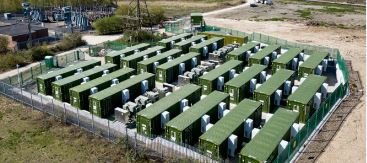UK battery storage has seen a ‘turning point and becomes an economically viable investment.
Session moderator Carina Radford’s law firm White & Case advised on the Neoen-Tesla Hornsdale Power Reserve project in South Australia. Image: Neoen-Tesla.
The battery storage market in the UK has become a viable investment opportunity in just the past few months, even without the backing of long-term contracts for grid services, according to an investment manager in the renewable energy sector. Jonty Lovell, investment manager at Foresight Group, said that the falling cost of energy storage and the evolution of an industry capable of monetising assets in merchant opportunities have brought the industry into a new phase of economic viability. Lovell was speaking on today’s final day of the Energy Storage Summit 2021 hosted by our publisher Solar Media.
The panel discussion on financing for merchant energy storage projects was moderated by Carina Radford, a partner at the law firm White & Case which has advised on some of the biggest battery storage projects in the world. That includes the Hornsdale Power Reserve in South Australia and just a few days ago worked on the closing of a financing deal for another 300MW project in Australia by the same partnership of Neoen and Tesla which delivered the 195MWh Hornsdale battery project.
Radford asked panellists including Lovell from Foresight and Olivier Fricot, senior coverage director of infrastructure and power finance at Investec, what they thought about the prospects of financing energy storage projects in 2021 look like.
Investec’s Olivier Fricot said that financing on a merchant basis is “not the easiest of things”. A lot of power and infrastructure investors whether debt or equity financing, have been living for years on a diet of long-term fixed cash flow investments. In the renewable energy sector, this has largely meant feed-in tariffs or other government-backed contract structures.
Those prepared to finance merchant projects and take the attendant risks are still a “small subset” of that investment class, he said. Battery storage as an investment is still a fairly new phenomenon, so it is perhaps to be expected that some investors will maintain a conservative outlook. Further to that, the structure of a revenue stack for energy storage projects will include some revenue streams that are “well known and others that are harder to pin down”.
Presumably referring to grid services markets, which can become saturated once a large number of batteries pile in, he said some market opportunities can be “actually fairly shallow and not particularly deep”.
“It’s quite easy to see a very, very credible revenue stack now, disappearing because of a simple law of supply and demand,” Fricot said. The main challenge in raising debt financing meanwhile is that the gearing, or level of lending required as a proportion of the cost of getting a project off the ground, is fairly high compared to other potential investments. Nonetheless, he said, the wider trend is that both capital expenditure and operating expenditure for battery storage are coming down with time and scale and he predicted that gearing could have a more positive ratio within two to three years.
However, looking at bigger picture trends even further, Foresight Group’s Jonty Lovell, who works primarily in equity investments, said that the investment case for battery storage can only improve. With the UK and other nations targeting net zero emissions by 2050 and the rise of renewable energy already underway against the reduction of reliance on fossil fuels, “the fundamentals are there and have been for a while,” Lovell said.
“We’re going to see an increasing level of renewables coming online, that is going to be displacing existing thermal generation, which is only going to increase intermittency of a generation going forward,” he said.
“Which is ultimately going to put a strain on the network and increase the level of volatility on the network which A) drives the need for storage and B) drives up the value of storage.” The UK’s enhanced frequency response (EFR) tender of 2016 kick-started the country’s grid services market opening to batteries, and equity investors made project finance investments then, because EFR contracts were long-term, and backed by the national transmission system operator, National Grid.
A lull followed that initial wave, but Lovell said that the last six to 12 months have seen a noticeable “turning point” in the sector, “where economics has started to become more viable, certainly for equity investors”.
Two key things are driving that change he said, one being the reduction in costs, especially a “drastic reduction in Capex over the last three years, so much so that we now believe that they’re at the kind of levels that can support viable projects”. While the other aspect is the development of a credible off-taker structure. He mentioned that there are entities optimising growing fleets of battery assets around the country on behalf of project owners and investors and earning them revenues that offer healthy returns.
“There are clearly a number of the route to market providers in the space of different sizes and different offerings. But what we’ve seen is certainly a development of those trading platforms and the business cases, and a demonstrable track record that these parties have been able to demonstrate over the past 18 to 24 months, which is helping equity providers get comfortable with the type of use cases. Before that, it was very much taking them at their word. Whereas now, there is kind of a track record that can be demonstrated.”
Lovell added that while it is true that some grid-balancing services markets may represent a relatively shallow market opportunity, the wholesale market is a “much deeper market,” along with the UK’s Balancing Mechanism which matches supply with demand for power. Those much deeper markets can support a much larger battery build-out than ancillary grid services opportunities and is where Foresight Group sees the “long-term value in these [battery storage] assets,” he said.
https://www.facebook.com/peftnmedianews https://www.twitter.com/TNMediaNews





